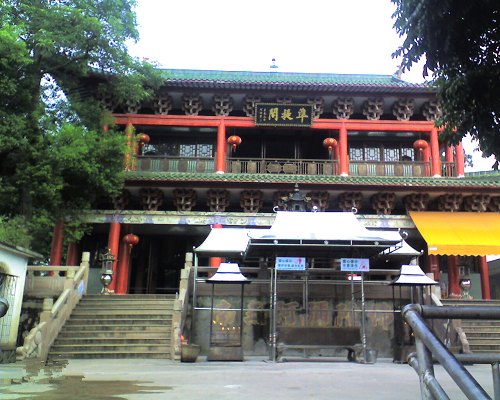
Zhunti Pavillion in Shiping County, Honghe
Zhunti Pavilion (准提阁) is an ancient building located on Zhuquan Street (珠泉街), Shiping County (石屏县), Yunnan Province (云南省), China. It has a long history and rich cultural heritage. Originally built during the Shunzhi (顺治) reign of the Qing Dynasty (清朝), the current main structures date from the Guangxu (光绪) period. In 1923, Shiping Middle School (石屏中学) was established inside the pavilion, marking a significant development in local education. In 1983, Zhunti Pavilion was officially listed as a cultural relic protection unit of Shiping County.
Architectural Structure
The Zhunti Pavilion complex consists of several key components:
- Main Gate – Serves as the primary entrance and an important visual landmark.
- Second Gate – Guides visitors deeper into the core area.
- Tianzun Hall (天尊殿) – An important part of the complex with high religious and cultural value.
- Zhunti Pavilion – The central building, featuring a double-eaved hip-and-gable roof (重檐歇山顶) with a combination of tie-beam and through-beam structural systems. The total facade width is 19.5 meters, depth 14.4 meters, with corridors on both east and west sides.
- Qihe Tower (企鹤楼) – Another eye-catching structure, built in the early Republic of China (民国) period, featuring a four-tier hip-and-gable roof (四重檐歇山顶).
The pavilion’s walls are decorated with inscriptions by notable figures such as Tu Rizhuo (涂日卓), Tang Jiyao (唐继尧), and Chen Rongchang (陈荣昌), offering valuable cultural heritage.
Historical Background
The ancient city of Shiping (石屏古城) is famously built upon a massive turtle-shaped rock, a legend passed down for over a thousand years. During the Xia (夏), Shang (商), and Zhou (周) dynasties, Shiping belonged to Liangzhou (梁州), one of the Nine Provinces (九州) of ancient China. Before the Qin (秦) dynasty, it was part of the State of Chu (楚国). In the Han (汉) dynasty, it was under Shengxiu County (胜休县) in Yizhou (益州), and during the Western Han (西汉), it was known as “Jiuxin” (旧欣).
In the Tianbao (天宝) era of the Tang Dynasty (唐朝), Yi (彝族) leader Wu Mo Man (乌么蛮) built a castle on the northwest of Mo Shu Island (末束岛) in Yilong Lake (异龙湖), first naming it Shipingyi (石坪邑). The city later moved to the west bank of Yilong Lake, its current location. In the Hongwu (洪武) period of the Ming (明) dynasty, it was renamed Shiping (石平), and in the early Republic of China, its name became Shiping (石屏).
Records from the Kangxi (康熙) reign of the Qing dynasty mention that Zhuge Liang (诸葛亮) passed through this area and described the turtle-shaped rock.
Notable Educational Institution
In 1923, the Shiping County Public Middle School (石屏县立中学校) was founded inside Zhunti Pavilion.
- In August 1933, it was renamed Yunnan Provincial Shiping Middle School (云南省立石屏中学校).
- In 1939, it became Yunnan Provincial Shiping Normal School (云南省石屏师范学校), including a junior middle school.
- In 1950, it merged with Shiping County United Middle School (石屏县联合中学).
- By 1952, it was officially named Yunnan Province Shiping County No. 1 Middle School (云南省石屏县第一中学).
This institution produced many prominent figures, including:
- Chen Fujin (陈福今) – Former Central Committee member and Vice President of the National Academy of Governance.
- Li Jiating (李嘉廷) – Former Governor of Yunnan Province.
- Yang Yuankai (杨元恺) – Senior Engineer at the Ministry of Aviation Industry.
- Yang Chunzhou (杨春洲) – Educator and photographer.
- Li Qiao (李乔) – Yi ethnic writer.
Unique Geological Features
Shiping Ancient City is uniquely built on a massive rock. Geological studies confirm this, and fresh spring water can be found beneath. Local legends speak of interconnected underground water systems, with stories claiming that a bucket of water drawn from one household’s well might appear in another’s.
One remarkable feature near Zhunti Pavilion is an artificially carved pool called Boizhu Spring (沸珠泉), where water bubbles up from the rock, creating a sound like applause to welcome visitors.
Cultural Significance
The unique geological setting and rich history make Shiping a cultural hotspot. The streets and alleys of the ancient city are lined with historic buildings, including more than ten temples. The city’s winding streets and interlinked courtyards reflect traditional local architectural style.
For centuries, Shiping has produced many scholars and officials. The saying “Five steps, three scholars; across the street, two Hanlins” (五步三学者,对门两翰林) illustrates its educational reputation.
How to Get There
- By Bus – Regular buses run from major cities in Yunnan to Shiping County.
- By Car – Drive along major highways to Shiping, then follow signs to Zhuquan Street.
- By Train – Travel to the nearest railway station, then take local transportation to the pavilion.
Travel Tips
- Best Time to Visit – Spring (March to May) and autumn (September to November) offer the most pleasant weather.
- Guided Tours – Hiring a local guide will enhance your understanding of the pavilion’s historical and cultural significance.
- Photography – Bring a camera to capture the stunning architecture and picturesque surroundings.
- Respect the Site – Be mindful of its historical importance and avoid damaging any structures or relics.

 7 Days GolfingTour
7 Days GolfingTour
 8 Days Group Tour
8 Days Group Tour
 8 Days Yunnan Tour
8 Days Yunnan Tour
 7 Days Shangri La Hiking
7 Days Shangri La Hiking
 11 Days Yunnan Tour
11 Days Yunnan Tour
 6 Days Yuanyang Terraces
6 Days Yuanyang Terraces
 11 Days Yunnan Tour
11 Days Yunnan Tour
 8 Days South Yunnan
8 Days South Yunnan
 7 Days Tea Tour
7 Days Tea Tour
 8 Days Muslim Tour
8 Days Muslim Tour
 12 Days Self-Driving
12 Days Self-Driving
 4 Days Haba Climbing
4 Days Haba Climbing
 Tiger Leaping Gorge
Tiger Leaping Gorge
 Stone Forest
Stone Forest
 Yunnan-Tibet
Yunnan-Tibet
 Hani Rice Terraces
Hani Rice Terraces
 Kunming
Kunming
 Lijiang
Lijiang
 Shangri-la
Shangri-la
 Dali
Dali
 XishuangBanna
XishuangBanna
 Honghe
Honghe
 Kunming
Kunming
 Lijiang
Lijiang
 Shangri-la
Shangri-la
 Yuanyang Rice Terraces
Yuanyang Rice Terraces
 Nujiang
Nujiang
 XishuangBanna
XishuangBanna
 Spring City Golf
Spring City Golf
 Snow Mountain Golf
Snow Mountain Golf
 Stone Mountain Golf
Stone Mountain Golf














